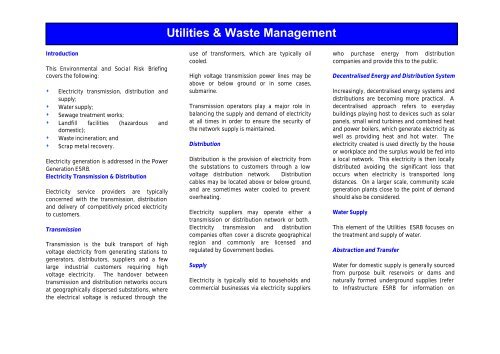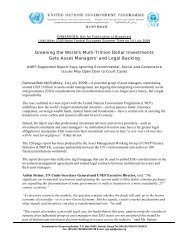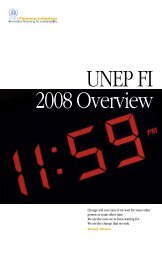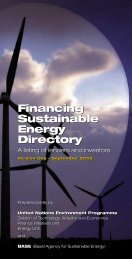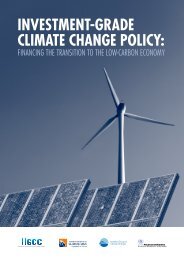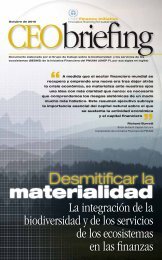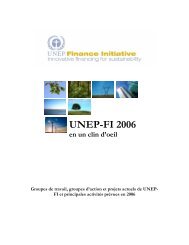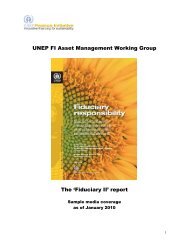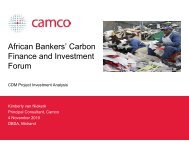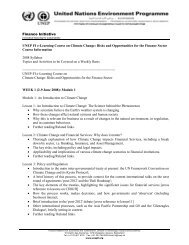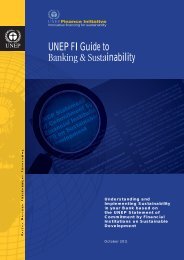Utilities & Waste Management - UNEP Finance Initiative
Utilities & Waste Management - UNEP Finance Initiative
Utilities & Waste Management - UNEP Finance Initiative
You also want an ePaper? Increase the reach of your titles
YUMPU automatically turns print PDFs into web optimized ePapers that Google loves.
<strong>Utilities</strong> & <strong>Waste</strong> <strong>Management</strong><br />
Introduction<br />
This Environmental and Social Risk Briefing<br />
covers the following:<br />
s<br />
Electricity transmission, distribution and<br />
supply;<br />
s Water supply;<br />
s Sewage treatment works;<br />
s Landfill facilities (hazardous and<br />
domestic);<br />
s <strong>Waste</strong> incineration; and<br />
Scrap metal recovery.<br />
s<br />
Electricity generation is addressed in the Power<br />
Generation ESRB.<br />
Electricity Transmission & Distribution<br />
Electricity service providers are typically<br />
concerned with the transmission, distribution<br />
and delivery of competitively priced electricity<br />
to customers.<br />
Transmission<br />
Transmission is the bulk transport of high<br />
voltage electricity from generating stations to<br />
generators, distributors, suppliers and a few<br />
large industrial customers requiring high<br />
voltage electricity. The handover between<br />
transmission and distribution networks occurs<br />
at geographically dispersed substations, where<br />
the electrical voltage is reduced through the<br />
use of transformers, which are typically oil<br />
cooled.<br />
High voltage transmission power lines may be<br />
above or below ground or in some cases,<br />
submarine.<br />
Transmission operators play a major role in<br />
balancing the supply and demand of electricity<br />
at all times in order to ensure the security of<br />
the network supply is maintained.<br />
Distribution<br />
Distribution is the provision of electricity from<br />
the substations to customers through a low<br />
voltage distribution network. Distribution<br />
cables may be located above or below ground,<br />
and are sometimes water cooled to prevent<br />
overheating.<br />
Electricity suppliers may operate either a<br />
transmission or distribution network or both.<br />
Electricity transmission and distribution<br />
companies often cover a discrete geographical<br />
region and commonly are licensed and<br />
regulated by Government bodies.<br />
Supply<br />
Electricity is typically sold to households and<br />
commercial businesses via electricity suppliers<br />
who purchase energy from distribution<br />
companies and provide this to the public.<br />
Decentralised Energy and Distribution System<br />
Increasingly, decentralised energy systems and<br />
distributions are becoming more practical. A<br />
decentralised approach refers to everyday<br />
buildings playing host to devices such as solar<br />
panels, small wind turbines and combined heat<br />
and power boilers, which generate electricity as<br />
well as providing heat and hot water. The<br />
electricity created is used directly by the house<br />
or workplace and the surplus would be fed into<br />
a local network. This electricity is then locally<br />
distributed avoiding the significant loss that<br />
occurs when electricity is transported long<br />
distances. On a larger scale, community scale<br />
generation plants close to the point of demand<br />
should also be considered.<br />
Water Supply<br />
This element of the <strong>Utilities</strong> ESRB focuses on<br />
the treatment and supply of water.<br />
Abstraction and Transfer<br />
Water for domestic supply is generally sourced<br />
from purpose built reservoirs or dams and<br />
naturally formed underground supplies (refer<br />
to Infrastructure ESRB for information on
<strong>Utilities</strong> & <strong>Waste</strong> <strong>Management</strong><br />
dams). Government authorities often strictly<br />
control abstraction from these sources.<br />
Water is transferred from sources to water<br />
treatment works via a system of pipes and<br />
pumping stations located in various areas.<br />
Water Treatment<br />
In general, water is treated using a multibarrier<br />
approach comprising coagulation and<br />
clarification, rapid gravity filtration or biological<br />
filtration and final disinfection. In addition,<br />
ozone and granular activated carbon<br />
techniques may be used for treatment of<br />
organic contaminants. Water sourced from<br />
borewells may undergo less treatment than<br />
reservoir water, as it is less contaminated. All<br />
water will undergo treatment with chlorine<br />
dioxide gas, which acts as a biocide. Sufficient<br />
treatment will result in the water being of<br />
drinking water quality.<br />
Storage and Distribution<br />
Subsequent to treatment, water is pumped in<br />
pipelines to underground storage tanks<br />
(service reservoirs), prior to distribution to<br />
consumers. Water is transferred from the<br />
service reservoirs via large capacity trunk<br />
mains underground pipelines and is either<br />
pumped or transferred by gravity. From trunk<br />
mains pipelines, the water is transferred to<br />
smaller capacity distribution pipelines and then<br />
to service connections, which supply water to<br />
individual buildings.<br />
In addition to providing a water supply, water<br />
companies typically:<br />
s Provide designs and quotations for new<br />
water mains and service connections,<br />
whether to serve a new development or as<br />
part of changes to a property;<br />
s Undertake network capacity<br />
investigations;<br />
s Undertake flow and pressure<br />
s<br />
s<br />
investigations;<br />
Provide new wastewater connections; and<br />
Provide connection to sewers.<br />
Sewage Treatment Works<br />
A sewage treatment works separates solids<br />
from liquids by physical processes and purifies<br />
the liquid by biological processes. Processes<br />
may vary but the following cycle is typical:<br />
Preliminary Treatment or “Screening”<br />
Solids like wood, paper, rags, and plastic are<br />
removed by screens, washed, dried and taken<br />
away for safe disposal at a licensed landfill.<br />
Grit and sand, which would damage pumps, is<br />
also removed and disposed of in a similar way.<br />
Primary Treatment<br />
Following screening, the remaining solids are<br />
separated from the liquid by passing the<br />
sewage through large settlement tanks, where<br />
most of the solid materials sink to the bottom.<br />
About 70% of solids settle out at this stage and<br />
are referred to as “sludge”. The sludge is used<br />
on farms as a fertiliser after further treatment<br />
called sludge treatment.<br />
Secondary Treatment<br />
Secondary treatment refers to the biological<br />
process, which relies on naturally occurring<br />
microorganisms acting to break down organic<br />
material and purify the waste liquid.<br />
In a simple sewage treatment process,<br />
microorganisms are encouraged to grow on<br />
stones over which the sewage is trickled. The<br />
microorganisms, which need oxygen to thrive,<br />
feed on the bacteria in the sewage and purify<br />
the water. These treatment units are called<br />
percolating filters. This process can be<br />
speeded up by blowing air into tanks of sewage<br />
where the microorganisms float freely and feed<br />
on the bacteria. These treatment units are<br />
called aeration tanks.<br />
Following either form of secondary treatment,<br />
the wastewater is settled in tanks to separate<br />
the biological sludge from the purified<br />
wastewater.
<strong>Utilities</strong> & <strong>Waste</strong> <strong>Management</strong><br />
The volume of the sludge varies substantially<br />
depending on what process that has been used<br />
and depending on where in the cycle the<br />
sludge is collected. The sludge needs to be<br />
stabilised and extraction of water. The are four<br />
methods to stabilise the sludge:<br />
s<br />
s<br />
s<br />
s<br />
Anaerobic stabilisation;<br />
Aerobic stabilisation;<br />
Chemical stabilisation; and<br />
Thermal stabilisation<br />
Typically, sludges are thickened (dewatered) to<br />
reduce the volumes transported off-site for<br />
disposal (landfill). There is no process, which<br />
completely eliminates the requirements for<br />
disposal of biosolids.<br />
Tertiary Treatment<br />
Sometimes, further treatment is needed to<br />
improve the quality of the wastewater. This is<br />
known as tertiary treatment. Various methods<br />
may be used including sand filters, reed beds<br />
or grass plots. Disinfection, using ultra violet<br />
light to kill bacteria, is another method being<br />
used at a number of coastal sewage treatment<br />
schemes.<br />
Landfill<br />
Landfill refers to a method for final disposal of<br />
solid waste on land. Most modern landfills are<br />
classified according to the type(s) of waste<br />
material disposed of into them.<br />
Hazardous <strong>Waste</strong> Landfill: waste disposal units<br />
constructed to specific design criteria and<br />
which receive wastes meeting the local<br />
definition of hazardous waste. These landfills<br />
are generally constructed to be secure<br />
repositories for material that presents a serious<br />
hazard to human health.<br />
Non Hazardous Landfills: also called modern,<br />
engineered or secure landfills, these usually<br />
have physical barriers such as liners and<br />
leachate collection systems and procedures to<br />
protect the public from exposure to the<br />
disposed wastes. The term sanitary landfill<br />
normally refers to those where municipal solid<br />
waste is disposed of, as well as other wastes<br />
high in organic material. In some countries, all<br />
landfills are sanitary landfills.<br />
Inert <strong>Waste</strong> Landfill: waste disposal units that<br />
receive wastes that are chemically and<br />
physically stable and do not undergo<br />
decomposition, such as sand, bricks, concrete<br />
or gravel.<br />
Typically a landfill facility may comprise the<br />
following components:<br />
s<br />
s<br />
s<br />
s<br />
s<br />
s<br />
A bottom liner system;<br />
A leachate collection and management<br />
system;<br />
A landfill gas management system;<br />
Supporting road network.<br />
A drainage system; and<br />
A final capping system.<br />
Their function is to secure the normal landfill<br />
operations and to control the anticipated<br />
emissions generated mainly by the<br />
decomposition of organic matter, such as<br />
contaminated leachate and landfill gas.<br />
Landfill gas, which is principally methane and<br />
carbon dioxide, arises when wastes<br />
decompose and can be potentially noxious and<br />
explosive. Landfill gas can though be<br />
harnessed to provide energy.<br />
<strong>Waste</strong> Incineration<br />
Incinerators operate by feeding wastes onto a<br />
moving grate where they are burned. The heat<br />
generated raises steam, which can be used to<br />
drive turbines to generate electricity (See<br />
Power Generation and Distribution ESRB -<br />
Energy from Biomass and <strong>Waste</strong>).<br />
Four main technologies exist for the<br />
incineration of waste:
<strong>Utilities</strong> & <strong>Waste</strong> <strong>Management</strong><br />
1. Mass burn: the simplest and most common<br />
form of incineration. Mixed waste is burnt and<br />
energy is recovered from hot combustion<br />
gases to generate electricity.<br />
2. Fluidised Bed Combustion (FBC): noncombustible<br />
components are removed and the<br />
remaining waste shredded to produce Refuse<br />
Derived Fuel (RDF). The RDF is fed into a bed<br />
made up of sand and dolomite. Air is pumped<br />
through the base to improve efficiency.<br />
3. Pyrolysis and Gasification: less commonly<br />
used methods and requires waste sorting and<br />
crushing. This pre-treatment leads to higher<br />
costs and uses more energy. Pyrolysis (please<br />
see Power Generation ESRB) refers to the<br />
heating of waste with no oxygen; gasification<br />
refers to the burning of waste in a low oxygen<br />
atmosphere to produce gas with low energy<br />
content.<br />
The burning of waste produces solid<br />
incinerator bottom ash, commonly disposed of<br />
at landfills or reused in construction and finer<br />
fly ash (flue gases and combustion products).<br />
The main pollutants of concern are dioxins,<br />
acid gases, nitrogen dioxides, heavy metals and<br />
particulate matter present in both bottom and<br />
fly ash. It is the presence of dioxins, which<br />
causes most concern due to their carcinogenic<br />
nature and the threat of bioaccumulation due<br />
to the ease of entering the human food chain.<br />
Scrap Metal Recovery<br />
In scrap metal recovery, large items are<br />
dismantled to separate metal from non-metal<br />
components, oils or other fluids are drained<br />
and non-metal components may be stripped<br />
off. The materials are then sorted and metal<br />
components are directed to a “fragmentiser”<br />
plant where they are broken up into suitable<br />
sized pieces for the melting process. Large<br />
metal objects such as cars are sheared and<br />
crushed before they are fragmentised. Nonmetal<br />
items such as plastics, textiles, rubber,<br />
oils and other fluids are disposed of as waste if<br />
no viable use can be found.<br />
Metals received on site may be oily or greasy<br />
and are cleaned using solvents. Contaminants<br />
will vary with the type of scrap metal stored<br />
and the processes carried out but may include<br />
metals (from dismantling/breaking activities),<br />
oils and fuels (from engines and storage tanks),<br />
acids (from batteries), solvents (used to clean<br />
metals), asbestos (from brake linings), acids,<br />
polychlorinated biphenols [PCBs] (toxic<br />
chemical compounds), degreasing agents and<br />
heavy metals.
<strong>Utilities</strong> & <strong>Waste</strong> <strong>Management</strong><br />
Key Sector Risks and Headline Issues<br />
In <strong>Utilities</strong> and <strong>Waste</strong> <strong>Management</strong> operations some critical issues of particular public concern may result in reputation or credit risk to a lender or an investor,<br />
these include:<br />
s<br />
s<br />
s<br />
s<br />
s<br />
Climate Change - greenhouse gas emissions from processing and landfills especially methane;<br />
Land contamination for gas storage<br />
Employee and Community Health and Safety in relation to gas explosion risk<br />
Ensuring wastewater is clean before disposal<br />
Water supply – sufficient quality public health<br />
The following tables detail potential environmental and social risks associated with industry processes and appropriate control measures. These may include<br />
Environmental and Social <strong>Management</strong> Plans and may form part of a wider Environmental Social <strong>Management</strong> System.
<strong>Utilities</strong> & <strong>Waste</strong> <strong>Management</strong><br />
Environmental Risks<br />
Life Cycle Phase<br />
Environmental<br />
and Activity Risks Controls<br />
Project Feasibility and Planning<br />
Landfill Facilities,<br />
Sewage Treatment<br />
Works, Scrap Metal<br />
Facilities, <strong>Waste</strong><br />
Incinerators<br />
s<br />
Site suitability - lack of road/rail infrastructure, land value,<br />
location of community to be served, cost of meeting<br />
government/regulatory requirements<br />
Gas Supply s Habitat depletion, fragmentation and degradation -<br />
disruption to habitat, disruption to remote sites that may<br />
have significant wilderness, scenic or recreation value,<br />
transmission and distribution route selection and suitability<br />
Water Supply s Pressure on natural resources - Water availability and<br />
silting of catchment area, reservoirs and underground<br />
abstractions<br />
s Habitat depletion, fragmentation and degradation -<br />
supply route selection and suitability -, disruption to<br />
remote sites that may have significant wilderness, scenic<br />
or recreation value<br />
Construction<br />
s<br />
s<br />
s<br />
s<br />
Minimize facility footprint - Project feasibility study and<br />
Environmental Impact Assessment<br />
Minimize facility footprint - Project feasibility study and<br />
Environmental Impact Assessment<br />
Minimize facility footprint - Project feasibility study and<br />
Environmental Impact Assessment<br />
Water disposal and monitoring systems – adequate planning<br />
and ongoing monitoring of aquifer conditions
<strong>Utilities</strong> & <strong>Waste</strong> <strong>Management</strong><br />
Life Cycle Phase<br />
Environmental<br />
and Activity Risks Controls<br />
Gas and Water<br />
Supply<br />
s<br />
s<br />
Atmospheric emissions:<br />
- Pollutants (VOC, NOX, SOX, PM10, CO, CO2, etc)<br />
- Greenhouse gas production<br />
- Dust and noise, vibration, vehicle/machinery<br />
Strain on infrastructure and public nuisance - disruption<br />
to public rights of way, road networks<br />
s Impact on terrestrial and aquatic ecology<br />
s Habitat depletion, fragmentation and degradation -<br />
- Land clearance, land disturbance, land stability<br />
- Erosion<br />
- Infrastructure development access roads, opening up of<br />
natural habitat<br />
- Use of remote sites that may have significant wilderness,<br />
scenic or recreation value<br />
s Disruption and pollution to groundwater<br />
s<br />
(hydrogeological) systems and flows<br />
Connections to grids - requirements for national grids<br />
s<br />
Minimize facility footprint<br />
- Utilise an Environmental Impact Assessment and<br />
Environmental <strong>Management</strong> System<br />
- Ensure that all construction activities are governed by<br />
appropriate environmental management plans (e.g. land use,<br />
ecological management/habitat restoration, erosion control,<br />
water quality, spill prevention and response, etc.) and that<br />
compliance is monitored<br />
- Rights of way management<br />
- Avoidance of populated areas<br />
- Avoidance of sensitive areas<br />
- Appropriate engineering design for local conditions<br />
s Emissions management - Minimise unnecessary use /<br />
movement of vehicles, plant and machinery<br />
s Hazardous waste, storage and disposal plans - employ<br />
appropriate health and safety measures for containment of<br />
chemicals
<strong>Utilities</strong> & <strong>Waste</strong> <strong>Management</strong><br />
Life Cycle Phase<br />
Environmental<br />
and Activity Risks Controls<br />
Sewage Treatment<br />
Works, Landfill<br />
Facilities, <strong>Waste</strong><br />
Incinerators, Scrap<br />
Metal Facilities<br />
s Habitat depletion, fragmentation and degradation -<br />
- Land acquisition, land disturbance, erosion and land<br />
stability<br />
- Infrastructure development e.g. access roads, opening up<br />
of natural habitat<br />
Operation<br />
s<br />
s<br />
Atmospheric emissions:<br />
- Pollutants (VOC, NOX, SOX, PM10, CO, CO2, etc)<br />
- Greenhouse gas production<br />
- Dust and noise<br />
Disruption and pollution of surface water (hydrological)<br />
systems and flows - particularly at landfill facilities<br />
s Disruption and pollution of ground water<br />
(hydrogeological) and surface water (hydrological)<br />
systems and flows - including hydrocarbon and chemical<br />
spills)<br />
Impact of terrestrial and aquatic ecology<br />
s<br />
Gas Supply s Natural hazards and risks -<br />
- Gas pipeline failure due to inadequate maintenance or<br />
catastrophic failure (e.g. puncture)<br />
s Atmospheric emissions:<br />
- Greenhouse gas emissions due to gas pipeline or gas<br />
storage leakage (methane) and compressor usage<br />
(methane, carbon dioxide)<br />
Water Supply s Natural risks and hazards - water pipeline failure due to<br />
inadequate maintenance or catastrophic failure - e.g.<br />
puncture<br />
s Pressure on natural resources - over-exploitation of water<br />
resources<br />
s Minimize facility footprint -<br />
- Utilise an Environmental Impact Assessment and<br />
Environmental <strong>Management</strong> System<br />
- Ensure that all construction activities are governed by<br />
appropriate environmental management plans (e.g. land use,<br />
ecological management/habitat restoration, erosion control,<br />
water quality, spill prevention and response, etc.) and that<br />
compliance is monitored<br />
- Rights of way management<br />
- Avoidance of populated areas<br />
- Avoidance of sensitive areas<br />
- Appropriate engineering design for local conditions<br />
s Emissions management - Minimise unnecessary use /<br />
s<br />
movement of vehicles, plant and machinery<br />
Hazardous waste, storage and disposal plans - employ<br />
appropriate health and safety measures for containment of<br />
chemicals<br />
s Emergency preparedness and spill response plans -<br />
management and training measures including appropriate<br />
inspection and maintenance programme of gas pipeline<br />
s Use of Best Available Technique not Entailing Excessive Cost<br />
(BATNEEC) - especially for compression stations<br />
s Emergency preparedness and spill response plans -<br />
management and training measures including appropriate<br />
inspection and maintenance programme of gas pipeline<br />
s Water disposal and monitoring systems - adequate planning<br />
and ongoing monitoring of hydrogeological/groundwater
<strong>Utilities</strong> & <strong>Waste</strong> <strong>Management</strong><br />
Life Cycle Phase<br />
Environmental<br />
and Activity Risks Controls<br />
s Impact of terrestrial and aquatic ecology - release of aquifers conditions<br />
chlorine and other treatment chemicals<br />
s Hazardous waste, storage and disposal plans - employ<br />
s Liquid waste (production and disposal) - including<br />
storage and handling of water treatment solids and sludge<br />
appropriate health and safety measures for containment<br />
hazardous materials (e.g. waste)<br />
Sewage Treatment<br />
Works<br />
s<br />
Biological disease and pestilence - use of biological films<br />
of protozoa, fungi and bacteria involving the spread of<br />
disease<br />
s Liquid waste (production and disposal)<br />
- Including storage and handling of water treatment solids<br />
and sludge<br />
- Disposal of ‘screened’ solids<br />
- Sludge disposal<br />
s Odour<br />
s Disruption and pollution of ground water<br />
(hydrogeological) systems and flows - storm water<br />
overflow, degradation of water quality, ecology and<br />
biodiversity impacts (loss of fish and aquatic invertebrates)<br />
s Impact of terrestrial and aquatic ecology - death of fish<br />
due to turbidity of water<br />
s Handling, storage and use of hazardous materials - land<br />
contamination, storage and handling of chemicals<br />
Landfill Facilities s Atmospheric emissions:<br />
- Pollutants (VOC, NOX, SOX, PM10, CO, CO2, etc)<br />
- Greenhouse gas production - greenhouse gases [e.g.<br />
landfill gas (methane)], explosions<br />
- Dust and noise - daily heavy goods vehicle (HGV)<br />
movements, dust creation<br />
s Disruption and pollution of groundwater<br />
s<br />
(hydrogeological) systems and flows - through leachate<br />
Landscape scarring and visual impact<br />
s<br />
s<br />
s<br />
s<br />
<strong>Waste</strong> management<br />
- Biological treatment management, controlled use of<br />
bacterial/fungal species<br />
- Reuse of sewage sludge e.g. as an agricultural fertiliser<br />
- Appropriate management of screened solids - disposal to<br />
landfill / incineration<br />
Emissions management - Assessment of odour concentration,<br />
intensity, character, odour control through enclosure, venting,<br />
good housekeeping such as maintenance of plant and<br />
equipment, locating or re-locating sources of odour as far as is<br />
practicable from the site boundary and nearby residents<br />
Hazardous waste, storage and disposal plans - employ<br />
appropriate health and safety measures for containment<br />
hazardous materials (e.g. waste)<br />
Pest control/management<br />
s Emissions management -<br />
-Minimise unnecessary use / movement of vehicles, plant and<br />
machinery<br />
-Dust suppression<br />
-Air quality monitoring and management, Landfill Gas<br />
<strong>Management</strong> Plan<br />
-Assessment of odour concentration, intensity and character<br />
(i.e. unpleasantness and offensiveness) – odour<br />
management system<br />
-Leachate management system, leachate collection and
<strong>Utilities</strong> & <strong>Waste</strong> <strong>Management</strong><br />
Life Cycle Phase<br />
Environmental<br />
and Activity Risks Controls<br />
s Biological disease and pestilence - vermin and pests and<br />
treatment<br />
resulting health and safety concerns<br />
s Pest control - regular flying of predatory birds e.g. hawks to<br />
s Bird nuisance<br />
control common species e.g. sea gulls, feral pigeon, rodent and<br />
Odour<br />
insect monitoring and control<br />
s Hazardous waste, storage and disposal plans - employ<br />
appropriate health and safety measures for containment<br />
hazardous materials (e.g. waste)<br />
s<br />
<strong>Waste</strong> Incinerators s Atmospheric emissions:<br />
- Pollutants (VOC, NOX, SOX, PM10, CO, CO2, etc) e.g.<br />
hydrogen, chloride, hydrogen fluoride and sulphur<br />
dioxide,<br />
- Greenhouse gas production - greenhouse gases<br />
- Dust and noise – fly and bottom ash, heavy metal<br />
contamination (e.g. cadmium, mercury, arsenic,<br />
vanadium)<br />
s Disruption and pollution of groundwater<br />
(hydrogeological) systems and flows - hydrocarbon /<br />
Scrap Metal<br />
Recovery Facility<br />
Decommissioning<br />
Planning and<br />
Execution<br />
chemical spills<br />
s Atmospheric emissions:<br />
- Pollutants (VOC, NOX, SOX, PM10, CO, CO2, etc)<br />
- Greenhouse gas production - greenhouse gases<br />
- Dust and noise<br />
s Disruption and pollution of groundwater<br />
(hydrogeological) systems and flows<br />
s Handling, use, storage, and disposal of hazardous<br />
materials<br />
s Habitat depletion, fragmentation and degradation - land<br />
contamination<br />
s<br />
s<br />
Land rehabilitation and restoration<br />
Site remediation/clean-up<br />
s<br />
Use of BATNEEC<br />
s Emergency preparedness and spill response plans -<br />
equipment maintenance and integrity testing<br />
s Emissions management - air quality monitoring and<br />
management, Air Quality <strong>Management</strong> Plan<br />
s Water disposal and monitoring systems - adequate planning<br />
and ongoing monitoring of hydrogeological/groundwater<br />
aquifers conditions<br />
s Hazardous waste, storage and disposal plans - employ<br />
appropriate health and safety measures for containment<br />
hazardous materials (e.g. waste)<br />
s<br />
Rehabilitation and Remediation <strong>Management</strong> Plan
<strong>Utilities</strong> & <strong>Waste</strong> <strong>Management</strong><br />
Social Risks<br />
Life Cycle Phase<br />
Social<br />
and Activity Risks Controls<br />
Project Feasibility and Planning<br />
Landfill Facilities,<br />
Sewage Treatment<br />
Works, Scrap Metal<br />
Facilities, <strong>Waste</strong><br />
Incinerators<br />
Gas and Water<br />
Supply<br />
Construction<br />
Gas and Water<br />
Supply<br />
s<br />
s<br />
s<br />
Site suitability - lack of road/rail infrastructure, land value,<br />
location of community to be served, cost of meeting<br />
government/regulatory requirements<br />
Site / route suitability - disruption and impact on local<br />
communities.<br />
Community health and safety - noise, vibration, dust<br />
creation, odour, emissions and air quality<br />
s Strain on infrastructure - strain on transport networks and<br />
local infrastructure movements, social conflict and unrest<br />
s Communicable diseases - spread of diseases to<br />
local/foreign populations<br />
s Land acquisition - displacement - loss of land leading to<br />
poverty, social disruption, migration, involuntary<br />
resettlement requiring relocation and compensation claims<br />
(particularly for dams and reservoirs)<br />
s Land acquisition - loss of access - impact on livelihoods<br />
and land value<br />
s Loss of livelihood - economic displacement - job<br />
competition, esp. people without formal land title, conflict<br />
between locals and outsiders<br />
s Employee Health and Safety - Employment and poor<br />
labour standards, child labour<br />
s Disruption of Social / community cohesion and<br />
exclusion of vulnerable groups<br />
s<br />
s<br />
s<br />
s<br />
Minimize facility footprint - Project feasibility study and Social<br />
Impact Assessment<br />
Minimize facility footprint - Project feasibility study and Social<br />
Impact Assessment<br />
Minimize facility footprint - right of way access management<br />
Community relations management - awareness raising and<br />
information dissemination on project<br />
s Social / community baseline assessment - establish<br />
community profiles (e.g. social hierarchy, ethnic groups, sociocultural<br />
and religious practices, skills profile) and public<br />
services/resources in a project area<br />
s<br />
s<br />
s<br />
Stakeholder consultation and management - Stakeholder<br />
identification and governmental/national/regional/local<br />
consultation<br />
Community / stakeholder relations management<br />
- <strong>Management</strong> of interface between local communities and<br />
outsiders through stakeholder identification and consultation<br />
(including governmental/national/regional/local stakeholders)<br />
- Community awareness raising and information dissemination<br />
on project<br />
- <strong>Management</strong> of community tensions, grievances and<br />
concerns through formal grievance mechanism<br />
Community investment and development - community
<strong>Utilities</strong> & <strong>Waste</strong> <strong>Management</strong><br />
Life Cycle Phase<br />
Social<br />
and Activity Risks Controls<br />
- Breakdown of social networks and structures<br />
- Socio-economic exclusion of ethnic minorities and<br />
investment (both long and short term) e.g. health care<br />
facilities, micro-finance initiatives and access to employment<br />
indigenous peoples<br />
- Socio-cultural tensions between local and foreign<br />
workforce from influx and outflow of migrants/ temporary<br />
workers and attraction of seasonal residents to project<br />
s<br />
s<br />
s<br />
Site Security Plans<br />
Community health and safety Plans - vaccinations and<br />
awareness raising on communicable diseases<br />
Responsible human resources policies - maximisation of local<br />
s<br />
area<br />
employment<br />
Stakeholder/Public Consultation and disclosure - social s Resettlement and relocation management - proper<br />
conflict and unrest due to operations and inadequate compensation, restoration of livelihoods and living standards<br />
information disclosure and explanation of project impacts<br />
Sewage Treatment<br />
Works, Landfill<br />
Facilities, <strong>Waste</strong><br />
Incinerators, Scrap<br />
Metal Facilities<br />
s<br />
Local procurement and business, unregulated trade<br />
s Host country governance, national economy and<br />
revenue transparency - sustainable growth and inflation,<br />
bribery, corruption and extortion<br />
s Strain on infrastructure and public nuisance - Strain on<br />
transport networks and local infrastructure and ability of<br />
social services to absorb new/foreign populations (supply<br />
and demand) including water resources, power, health,<br />
education, housing<br />
s<br />
Community health and safety - noise, vibration, dust<br />
creation, odour, traffic movements, emissions and air<br />
quality, social conflict and unrest<br />
s Communicable diseases - spread of diseases to<br />
local/foreign populations<br />
s Land acquisition - displacement - loss of land leading to<br />
poverty, social disruption, migration, involuntary<br />
resettlement requiring relocation and compensation claims<br />
(particularly for dams and reservoirs)<br />
s Loss of livelihood - economic displacement esp. income<br />
and land depreciation<br />
Land acquisition - loss of access - impact on livelihoods<br />
s<br />
s<br />
s<br />
Cultural heritage / archaeology management - identification,<br />
classification and protection of cultural / archaeological sites in<br />
accordance with the country’s laws/international standards<br />
and conventions<br />
Procurement and supply chain management<br />
s Partnering with and supporting host governments -<br />
- Encourage revenue transparency and good governance<br />
- Compliance with national / regional / local regulations<br />
s Community relations management - awareness raising and<br />
information dissemination on project and cultural awareness<br />
training<br />
s Social / community baseline assessment - establish<br />
community profiles (e.g. social hierarchy, ethnic groups, sociocultural<br />
and religious practices, skills profile) and public<br />
services/resources in a project area<br />
s Community / stakeholder relations management -<br />
- <strong>Management</strong> of interface between local communities and<br />
outsiders through stakeholder identification and consultation<br />
(including governmental/national/regional/local stakeholders)<br />
- Community awareness raising and information dissemination
<strong>Utilities</strong> & <strong>Waste</strong> <strong>Management</strong><br />
Life Cycle Phase<br />
Social<br />
and Activity Risks Controls<br />
Operation<br />
and land value, compensation claims,<br />
temporary/permanent relocation of communities<br />
(particularly for dam and reservoir construction)<br />
s Employee health and safety - Employment and Labour<br />
standards - child labour and human rights<br />
s Disruption of social / community cohesion and exclusion<br />
of vulnerable groups -<br />
- Breakdown of social networks and structures<br />
- Socio-economic exclusion of ethnic minorities and<br />
indigenous peoples<br />
- Socio-cultural tensions between local and foreign<br />
workforce from influx and outflow of migrants/ temporary<br />
workers and attraction of seasonal residents to project<br />
area<br />
s Stakeholder/public consultation and disclosure - social<br />
conflict and unrest due to operations and inadequate<br />
information disclosure and explanation of project impacts<br />
s Local procurement and business, unregulated trade<br />
s Host country governance, national economy and<br />
revenue transparency - sustainable growth and inflation,<br />
bribery, corruption and extortion<br />
s Strain on infrastructure and public nuisance - strain on<br />
transport networks and local infrastructure and ability of<br />
social services to absorb new/foreign populations (supply<br />
and demand) including water resources, power, health,<br />
education, housing<br />
Gas Supply s Employee health and safety - employment and labour<br />
standards<br />
Community health and safety - noise, vibration, odour,<br />
s<br />
on project<br />
- <strong>Management</strong> of community tensions, grievances and<br />
concerns through formal grievance mechanism<br />
s Community investment and development - community<br />
investment (both long and short term) e.g. health care<br />
facilities, micro-finance initiatives and access to employment<br />
s Site security plans<br />
s Community health and safety plans - vaccinations and<br />
awareness raising on communicable diseases<br />
s Resettlement and relocation management - proper<br />
compensation, restoration of livelihoods and living standards<br />
s Human resources policies - maximization of local employment<br />
s Cultural heritage / archaeology management - identification,<br />
classification and protection of cultural / archaeological sites in<br />
accordance with the country’s laws/international standards<br />
and conventions<br />
s Supply chain sustainability<br />
- Procurement and supply chain management including all<br />
sponsor developed Environmental Impact Statements are<br />
reviewed by independent third party reviewer<br />
s Partnering with and supporting host governments<br />
- Encourage revenue transparency and good governance<br />
- Compliance with national / regional / local regulations<br />
s<br />
Employee health and safety plans - procedures and training<br />
s Emergency preparedness and spill response plans -<br />
equipment maintenance and integrity testing Emergency
<strong>Utilities</strong> & <strong>Waste</strong> <strong>Management</strong><br />
Life Cycle Phase<br />
Social<br />
and Activity Risks Controls<br />
traffic movement, emissions and air quality<br />
Response and Crisis Planning<br />
s Natural hazards and risks - gas pipeline/storage failure<br />
and gas leaks from distribution network or customer<br />
homes<br />
s<br />
s<br />
Supply chain sustainability - security of supply and<br />
provision of ongoing supply to customers<br />
s Employee health and safety - employment and labour<br />
standards Worker health and safety during<br />
inspections/maintenance<br />
s Community health and safety Noise, vibration, dust<br />
creation, vehicular movement, emissions and air quality<br />
during routine or emergency maintenance work<br />
s Fuel poverty of vulnerable customers - bad<br />
publicity/press<br />
s Employee health and safety - Employment and poor<br />
labour standards<br />
s Disruption of social / community cohesion and exclusion<br />
of vulnerable groups<br />
- Breakdown of social networks and structures<br />
- Socio-economic exclusion of ethnic minorities and<br />
indigenous peoples<br />
- Socio-cultural tensions between local and foreign<br />
workforce from influx and outflow of migrants/ temporary<br />
workers and attraction of seasonal residents to project<br />
s Stakeholder / public consultation and disclosure - social<br />
conflict and unrest due to operations and inadequate<br />
information disclosure and explanation of project impacts<br />
s Local procurement and business, unregulated trade<br />
s Host country governance, national economy and<br />
revenue transparency - sustainable growth and inflation,<br />
bribery, corruption and extortion<br />
Community relations management - awareness raising and<br />
information dissemination on project and cultural awareness<br />
training<br />
s Social / community baseline assessment - establish<br />
community profiles (e.g. social hierarchy, ethnic groups, sociocultural<br />
and religious practices, skills profile) and public<br />
services/resources in a project area<br />
s<br />
s<br />
s<br />
s<br />
s<br />
s<br />
s<br />
Stakeholder consultation and management Stakeholder<br />
identification and governmental/national/regional/local<br />
consultation<br />
Community Relations - implementation of fuel poverty<br />
programmes to assist vulnerable customers<br />
Community investment and development - community<br />
investment (both long and short term) e.g. health care<br />
facilities, micro-finance initiatives and access to employment<br />
Community / stakeholder relations management<br />
- <strong>Management</strong> of interface between local communities and<br />
outsiders through stakeholder identification and consultation<br />
(including governmental/national/regional/local stakeholders)<br />
- Community awareness raising and information dissemination<br />
on project and cultural awareness training<br />
- <strong>Management</strong> of community tensions, grievances and<br />
concerns through formal grievance mechanism<br />
Site security plans<br />
Supply chain sustainability<br />
- Procurement and supply chain management including all<br />
sponsor developed Environmental Impact Statements are<br />
reviewed by independent third party reviewer<br />
Partnering with and supporting host governments<br />
- Encourage revenue transparency and good governance
<strong>Utilities</strong> & <strong>Waste</strong> <strong>Management</strong><br />
Life Cycle Phase<br />
Social<br />
and Activity Risks Controls<br />
- Compliance with national / regional / local regulations<br />
s International standards, guidelines and industry best practice<br />
- ensure that operations follow IFC Guidelines and where<br />
possible the Voluntary and Equator Principles (please see<br />
Regulation and Best Practice below)<br />
Water Supply s Natural hazards and risks - water pipeline failure -,<br />
security of supply /and provision of ongoing supply of<br />
water<br />
s Communicable diseases - Control of disease and<br />
contaminants in water supply (water quality) - security of<br />
supply and community health<br />
s Pressure on natural resources - Over-exploitation of<br />
water resources leading to community water shortage<br />
s Employee health and safety - Worker health and safety<br />
during inspections/maintenance<br />
s Community health and safety -<br />
- Noise, vibration, dust creation, vehicular movement,<br />
emissions and air quality during routine or emergency<br />
maintenance work<br />
- Release of chlorine and other treatment chemicals<br />
s Employee health and safety - Employment and poor<br />
labour standards<br />
s Disruption of social / community cohesion and exclusion<br />
of vulnerable groups -<br />
- Breakdown of social networks and structures<br />
- Socio-economic exclusion of ethnic minorities and<br />
indigenous peoples<br />
- Socio-cultural tensions between local and foreign<br />
workforce from influx and outflow of migrants/ temporary<br />
workers and attraction of seasonal residents to project<br />
Stakeholder / public consultation and disclosure - social<br />
s<br />
s<br />
Emergency preparedness and spill response plans<br />
- Equipment maintenance and integrity testing Emergency<br />
Response and Crisis Planning<br />
- Including appropriate inspection and maintenance<br />
programme<br />
- Adequate controls, testing, planning, and ongoing monitoring<br />
of hydrogeological conditions<br />
s Hazardous waste, storage and disposal plans - employ<br />
appropriate health and safety measures for containment<br />
hazardous materials (e.g. waste)<br />
s Social / community baseline assessment - establish<br />
community profiles (e.g. social hierarchy, ethnic groups, sociocultural<br />
and religious practices, skills profile) and public<br />
services/resources in a project area<br />
s Stakeholder consultation and management Stakeholder<br />
identification and governmental/national/regional/local<br />
consultation<br />
s Site security plans<br />
s Community / stakeholder relations management<br />
- <strong>Management</strong> of interface between local communities and<br />
outsiders through stakeholder identification and consultation<br />
(including governmental/national/regional/local stakeholders)<br />
- Community awareness raising and information dissemination<br />
on project and cultural awareness training<br />
- <strong>Management</strong> of community tensions, grievances and<br />
concerns through formal grievance mechanism
<strong>Utilities</strong> & <strong>Waste</strong> <strong>Management</strong><br />
Life Cycle Phase<br />
Social<br />
and Activity Risks Controls<br />
Sewage Treatment<br />
Works<br />
conflict and unrest due to operations and inadequate<br />
information disclosure and explanation of project impacts<br />
s Local procurement and business, unregulated trade<br />
s Host country governance, national economy and<br />
revenue transparency - sustainable growth and inflation,<br />
bribery, corruption and extortion<br />
s<br />
Community health and safety - noise, vibration, odour,<br />
traffic movements, emissions and air quality<br />
Landfill Facilities s Strain on infrastructure and public nuisance - strain on<br />
transport networks and local infrastructure, odour<br />
nuisance and public opposition<br />
s Biological disease and pestilence - vermin and pests<br />
s Employee health and safety - employment and poor<br />
labour standards, child labour<br />
<strong>Waste</strong> Incinerators s Community health and safety - noise, vibration, dust<br />
creation, odour, traffic movements, emissions and air<br />
quality,<br />
s Land acquisition - displacement - loss of land leading to<br />
poverty, social disruption, migration, involuntary<br />
resettlement requiring relocation and compensation claims<br />
(particularly for dams and reservoirs)<br />
s<br />
Community investment and development - community<br />
investment (both long and short term) e.g. health care<br />
facilities, micro-finance initiatives and access to employment<br />
s Responsible human resources policies - maximization of local<br />
employment<br />
s Supply chain sustainability -<br />
- Procurement and supply chain management including all<br />
sponsor developed Environmental Impact Statements are<br />
reviewed by independent third party reviewer<br />
s Partnering with and supporting host governments -<br />
- Encourage revenue transparency and good governance<br />
- Compliance with national / regional / local regulations<br />
s Emissions management -<br />
- Assessment of odour concentration, intensity - odour control,<br />
management and recording of complaints<br />
- Minimise unnecessary use / movement of vehicles, plant and<br />
machinery<br />
s Emissions management -<br />
- Minimise unnecessary use / movement of vehicles, plant and<br />
machinery<br />
- Dust suppression<br />
s<br />
Community relations management - awareness raising and<br />
information dissemination on project and cultural awareness<br />
training<br />
s Stakeholder consultation and management - stakeholder<br />
identification and governmental/national/regional/local<br />
consultation<br />
s Community / stakeholder relations management -
<strong>Utilities</strong> & <strong>Waste</strong> <strong>Management</strong><br />
Life Cycle Phase<br />
Social<br />
and Activity Risks Controls<br />
Scrap Metal<br />
Recovery Facility<br />
s<br />
s<br />
s<br />
s<br />
Loss of livelihood - economic displacement esp. income<br />
and land depreciation<br />
Land acquisition - loss of access - impact on livelihoods<br />
and land value, compensation claims,<br />
temporary/permanent relocation of communities<br />
(particularly for dam and reservoir construction)<br />
Employment health and safety - Employment and poor<br />
labour standards<br />
Stakeholder / public consultation and disclosure - NGOs,<br />
local and national advocacy groups, badly managed social<br />
and community relations, negative exposure,<br />
compensation claims<br />
s Community health and safety - noise, vibration, dust<br />
creation, odour, traffic movements, emissions and air<br />
quality<br />
s Loss of livelihood - economic displacement, job<br />
competition, loss of income<br />
s Disruption of Social / community cohesion and<br />
exclusion of vulnerable groups<br />
- Breakdown of social networks and structures<br />
- Socio-economic exclusion of ethnic minorities and<br />
indigenous peoples<br />
s<br />
- <strong>Management</strong> of interface between local communities and<br />
outsiders through stakeholder identification and consultation<br />
(including governmental/national/regional/local stakeholders)<br />
- Community awareness raising and information dissemination<br />
on project and cultural awareness training<br />
- <strong>Management</strong> of community tensions, grievances and<br />
concerns through formal grievance mechanism<br />
Community investment and development - community<br />
investment (both long and short term) e.g. health care<br />
facilities, micro-finance initiatives and access to employment<br />
Site security plans<br />
s<br />
s Employee health and safety plans - procedures and training<br />
s Human Resources policies - maximization of local<br />
employment<br />
s Supply chain sustainability -<br />
- Procurement and supply chain management including all<br />
sponsor developed Environmental Impact Statements are<br />
reviewed by independent third party reviewer<br />
s Partnering with and supporting host governments -<br />
- Encourage revenue transparency and good governance<br />
- Compliance with national / regional / local regulations<br />
s<br />
s<br />
s<br />
s<br />
Community relations management - awareness raising and<br />
information dissemination on project and cultural awareness<br />
training<br />
Stakeholder consultation and management - Stakeholder<br />
identification and governmental/national/regional/local<br />
consultation<br />
Employee health and safety plans - procedures and training<br />
Responsible human resources policies - maximization of local<br />
employment
<strong>Utilities</strong> & <strong>Waste</strong> <strong>Management</strong><br />
Life Cycle Phase<br />
Social<br />
and Activity Risks Controls<br />
Decommissioning<br />
Planning and<br />
Execution<br />
s<br />
s<br />
s<br />
s<br />
- Socio-cultural tensions between local and foreign<br />
workforce from influx and outflow of migrants/ temporary<br />
workers and attraction of seasonal residents to project<br />
Employee health and safety - employment and labour<br />
standards<br />
Loss of livelihood - economic displacement - loss of<br />
income, dependency on project related jobs<br />
Land acquisition - land rehabilitation and restoration<br />
Site remediation / clean-up<br />
s<br />
Rehabilitation and remediation management plan
<strong>Utilities</strong> & <strong>Waste</strong> <strong>Management</strong><br />
Key Considerations<br />
1. Does the operation hold all necessary environmental authorisations and permits and is the operation in full compliance with their requirements?<br />
2. Have any complaints been made against site operators or are there any outstanding prosecutions?<br />
3. Has any on-site waste/sewage sludge disposal ever taken place? How are waste products treated and disposed of in general?<br />
4. Does the company discharge effluent to a surface watercourse?<br />
5. Are there any extraordinarily high-risk site-specific issues (e.g. incineration of hazardous as opposed to municipal waste), does the facility handle scrap<br />
metals contaminated with hazardous substances?<br />
6. Is the company sufficiently financially robust to meet environmental responsibilities attached to site licenses, including decommissioning, rehabilitation<br />
and restoration costs?<br />
7. What procedures and/or resources exist to manage environmental risks (e.g. environmental management systems, auditing arrangements, dedicated<br />
personnel etc.)?<br />
Has an Environmental Impact Assessment been commissioned where required?
<strong>Utilities</strong> & <strong>Waste</strong> <strong>Management</strong><br />
Regulatory and Best Practice Reference Documents<br />
In the case of almost all large-scale new build, expansion and development projects an environmental and social Impact Assessment will be required<br />
particularly where project debt financing is being sought. A comprehensive ESIA undertaken to international standards allows both the project sponsor and<br />
the investors to assess the full range of potential environmental and social impacts related to a project development, operation and decommissioning. Part of<br />
the ESIA process is to design appropriate mitigation measures and to set a framework for the monitoring the performance of these measures on a long-term<br />
basis. This limits and controls compliance and remediation costs as well as long term credit and reputation risks.<br />
Source<br />
Multilateral<br />
Governmen<br />
t<br />
Agency / Body<br />
IFC Performance Standards<br />
http://www.ifc.org/ifcext/enviro.nsf/Content/PerformanceStandards<br />
World Bank Group Pollution Prevention and Abatement Handbook<br />
http://lnweb18.worldbank.org/ESSD/envext.nsf/51ByDocName/PollutionPreventionandAbatementHandbook<br />
UNESCO Conference on Indigenous People<br />
http://portal.unesco.org/sc_nat/ev.php?URL_ID=3854&URL_DO=DO_TOPIC&URL_SECTION=201&reload=1092045126<br />
EU Directive for <strong>Waste</strong> <strong>Management</strong><br />
http://www.wbcsd.org/Plugins/DocSearch/details.asp?ObjectId=MTg4OTE<br />
EU Policies: Integrated Pollution prevention and control.<br />
http://europa.eu/scadplus/leg/en/lvb/l28045.htm<br />
International Labour Organization: Mandate<br />
http://www.ilo.org/public/english/about/index.htm<br />
ILO’s Lists of Subjects Standards have been decided uponhttp://www.ilo.org/ilolex/english/subjectE.htm<br />
Security Issues and Human Rights<br />
http://www.voluntaryprinciples.org/principles/private.php<br />
World Health Organization (WHO) Best Practice guide to small-scale incineration<br />
http://www.who.int/water_sanitation_health/medicalwaste/smallincinerators/en/index.html<br />
Environment Agency UK Monitoring Guidance notes for emission levels<br />
http://www.environment-agency.gov.uk/business/444217/444661/444671/466158/monitoring/?version=1&lang=_e<br />
Health and Safety Executive Noise Regulations (complete)
<strong>Utilities</strong> & <strong>Waste</strong> <strong>Management</strong><br />
Source<br />
Industry<br />
Associatio<br />
n<br />
Agency / Body<br />
http://www.hse.gov.uk/noise/regulations.htm<br />
Health and Safety Executive Guidance for Employers for the Control of Noise at Work Regulations 2005<br />
http://www.hse.gov.uk/pubns/indg362.pdf<br />
UK Department for the Environment, Food and Rural Affairs (DEFRA)<br />
Code of Practice on Odour Nuisance from Sewage Treatment Works<br />
http://www.defra.gov.uk/environment/localenv/odour/pdf/sewageodour-cop.pdf<br />
Environment Agency (UK) <strong>Waste</strong> industry guidelines<br />
http://www.environment-agency.gov.uk/business/444304/444641/595811/?version=1&lang=_e<br />
Environment Agency 2002 (UK) Best Practice Guidance Recovery & Disposal of Hazardous & Non-Hazardous <strong>Waste</strong> (Other than by Incineration<br />
& Landfill)<br />
http://www.environment-agency.gov.uk/commondata/acrobat/chemicalbestpract_652800.pdf<br />
Netregs (Industry guidance, UK) Information on waste incineration and guidance with legislation<br />
http://www.netregs.gov.uk/netregs/275207/1108823/?version=1&lang=_e<br />
Netregs (Industry guidance, UK) Information on landfill and guidance with legislation<br />
http://www.netregs.gov.uk/netregs/275207/663559/?version=1&lang=_e<br />
Health Canada Guidelines on Noise in the Workplace<br />
http://www.hc-sc.gc.ca/ewh-semt/pubs/noise-bruit/insider7/index_e.html<br />
Traffic Noise Information and Recommendations<br />
http://www.hc-sc.gc.ca/ewh-semt/pubs/noise-bruit/insider8/index_e.html<br />
Canada Labour Code Federal Law and Regulations<br />
http://www.hrsdc.gc.ca/asp/gateway.asp?hr=/en/lp/lo/fll/part2/index-fll.shtml&hs=oxs<br />
Best Practice guidelines for gas and electricity network operator credit cover. Conclusions document. The Office of Gas and Electricity Markets<br />
(UK) (Ofgem 2005)<br />
http://www.ofgem.gov.uk/temp/ofgem/cache/cmsattach/10370_5805.pdf?wtfrom=/ofgem/work/index.jsp§ion=/areasofwork/creditc<br />
over


